User:Bicycle tourer/Confluence Types Reference
Jump to navigation
Jump to search
| Id | Image | Properties | Explanation |
|---|---|---|---|
| 1 | 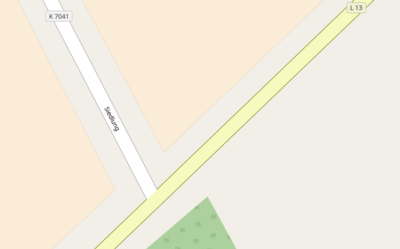
|
Carriageways in merging road: Single Links from merging road: 0 Carriageways in receiving road: Single Connection between receiving carriageways: <na> |
Type 1: Simple confluence (single carriageways road merging into single carriage road, no link)
|
| 1a | 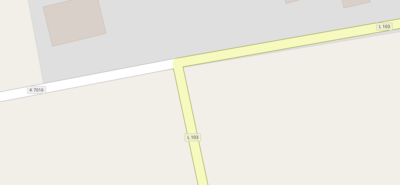
|
Carriageways in merging road: Single Links from merging road: 0 Carriageways in receiving road: Single Connection between receiving carriageways: <na> |
Type 1a: Bending confluence (single carriageways road merging into single carriage road, no link)
|
| 2 | Image tbd | Carriageways in merging road: single Links from merging road: leaving Carriageways in receiving road: single Connection between receiving carriageways: <na> |
Type 2: Confluence with single carriageway road merging into single carriageway road, single link on leaving side
|
| 3 | 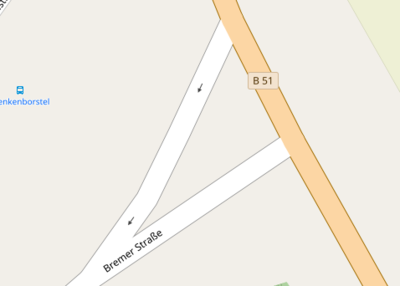
|
Carriageways in merging road: single Links from merging road: entering Carriageways in receiving road: single Connection between receiving carriageways: <na> |
Type 3: Confluence with single carriageway road merging into single carriageway road, single link on entering side
|
| 4 | Image tbd | Carriageways in merging road: single Links from merging road: leaving + entering Carriageways in receiving road: single Connection between receiving carriageways: <na> |
Type 4: Confluence with single carriageway road merging into single carriageway road, links on leaving and entering side
|
| 5 | Image tbd | Carriageways in merging road: dual common Links from merging road: 0 Carriageways in receiving road: single Connection between receiving carriageways: <na> |
Type 5: Confluence with dual carriageways road merging into single carriageway road, no links at all
|
| 6 | Image tbd | Carriageways in merging road: dual common Links from merging road: leaving Carriageways in receiving road: single Connection between receiving carriageways: <na> |
Type 6: Confluence with dual carriageways road merging into single carriageway road, single link on leaving side
|
| 7 | 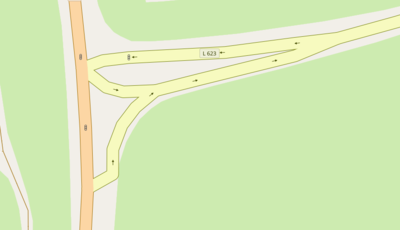
|
Carriageways in merging road: dual common Links from merging road: entering Carriageways in receiving road: single Connection between receiving carriageways: <na> |
Type 7: Confluence with dual carriageways road merging into single carriageway road, single link on entering side
|
| 8 | Image tbd | Carriageways in merging road: dual common Links from merging road: leaving + entering Carriageways in receiving road: single Connection between receiving carriageways: <na> |
Type 8: Confluence with dual carriageways road merging into single carriageway road, links on leaving and entering side
|
| 9 | Image tbd | Carriageways in merging road: dual separated Links from merging road: 0 Carriageways in receiving road: single Connection between receiving carriageways: <na> |
Type 9: Confluence with dual carriageways road merging into single carriageway road, no links at all
|
| 10 | Image tbd | Carriageways in merging road: dual separated Links from merging road: leaving Carriageways in receiving road: single Connection between receiving carriageways: <na> |
Type 10: Confluence with dual carriageways road merging separated into single carriageway road, single link on leaving side
|
| 11 | Image tbd | Carriageways in merging road: dual separated Links from merging road: entering Carriageways in receiving road: single Connection between receiving carriageways: <na> |
Type 11: Confluence with dual carriageways road merging separated into single carriageway road, single link on entering side
|
| 12 | 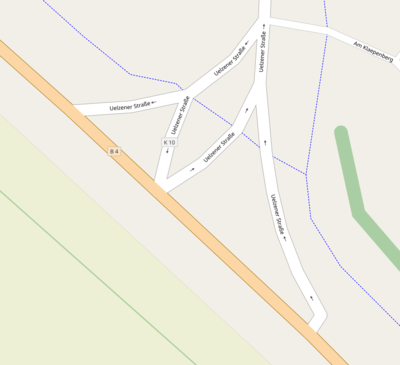
|
Carriageways in merging road: dual separated Links from merging road: leaving + entering Carriageways in receiving road: single Connection between receiving carriageways: <na> |
|
| 13 | 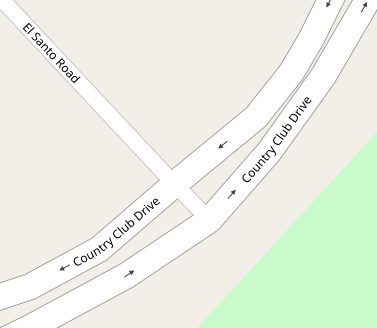
|
Carriageways in merging road: single Links from merging road: 0 Carriageways in receiving road: double Connection between receiving carriageways: single |
|
| 14 | Image tbd | Carriageways in merging road: single Links from merging road: leaving Carriageways in receiving road: double Connection between receiving carriageways: single |
Type 14: Confluence with single carriageway road merging into dual carriageways road with single connection, single link on leaving side
|
| 15 | Image tbd | Carriageways in merging road: single Links from merging road: entering Carriageways in receiving road: double Connection between receiving carriageways: single |
Type 15: Confluence with single carriageway road merging into dual carriageways road with single connection, single link on entering side
|
| 16 | Image tbd | Carriageways in merging road: single Links from merging road: leaving + entering Carriageways in receiving road: double Connection between receiving carriageways: single |
Type 16: Confluence with single carriageway road merging into dual carriageways road with single connection, links on leaving and entering side
|
| 17 | Image tbd | Carriageways in merging road: single Links from merging road: 0 Carriageways in receiving road: double Connection between receiving carriageways: dual connected |
Type 17: Confluence with single carriageway road merging into dual carriageways road with connected connection, no links at all
|
| 18 | Image tbd | Carriageways in merging road: single Links from merging road: leaving Carriageways in receiving road: double Connection between receiving carriageways: dual connected |
Type 18: Confluence with single carriageways road merging into dual carriageways road with connected connection, leaving link
|
| 19 | Image tbd | Carriageways in merging road: single Links from merging road: entering Carriageways in receiving road: double Connection between receiving carriageways: dual connected |
Type 17: Confluence with single carriageways road merging into dual carriageways road with connected connection, entering link
|
| 20 | Image tbd | Carriageways in merging road: single Links from merging road: leaving + entering Carriageways in receiving road: double Connection between receiving carriageways: dual connected |
Type 20: Confluence with single carriageways road merging into dual carriageways road with connected connection, leaving and entering links
|
| 21 | Image tbd | Carriageways in merging road: single Links from merging road: 0 Carriageways in receiving road: double Connection between receiving carriageways: dual separated |
Type 21: Confluence with single carriageways road merging into dual carriageways road with separated connections, no links at all
|
| 22 | Image tbd | Carriageways in merging road: single Links from merging road: leaving Carriageways in receiving road: double Connection between receiving carriageways: dual separated |
Type 22: Confluence with single carriageways road merging into dual carriageways road with separated connections, leaving link
|
| 23 | Image tbd | Carriageways in merging road: single Links from merging road: entering Carriageways in receiving road: double Connection between receiving carriageways: dual separated |
Type 23: Confluence with single carriageways road merging into dual carriageways road with separated connections, entering link
|
| 24 | Image tbd | Carriageways in merging road: single Links from merging road: leaving + entering Carriageways in receiving road: double Connection between receiving carriageways: dual separated |
Type 24: Confluence with single carriageways road merging into dual carriageways road with separated connections, leaving and entering links
|
| 25 | Image tbd | Carriageways in merging road: single Links from merging road: 0 Carriageways in receiving road: double Connection between receiving carriageways: dual reverse |
Type 25: Confluence with single carriageways road merging into dual carriageways road with separated connections, no links at all
|
| 26 | Image tbd | Carriageways in merging road: single Links from merging road: leaving Carriageways in receiving road: double Connection between receiving carriageways: dual reverse |
Type 26: Confluence with single carriageways road merging into dual carriageways road with separated connections, leaving link
|
| 27 | Image tbd | Carriageways in merging road: single Links from merging road: entering Carriageways in receiving road: double Connection between receiving carriageways: dual reverse |
Type 27: Confluence with single carriageways road merging into dual carriageways road with separated connections, entering link
|
| 28 | Image tbd | Carriageways in merging road: single Links from merging road: leaving + entering Carriageways in receiving road: double Connection between receiving carriageways: dual reverse |
Type 28: Confluence with single carriageways road merging into dual carriageways road with separated connections, leaving + entering link
|
| 29 | 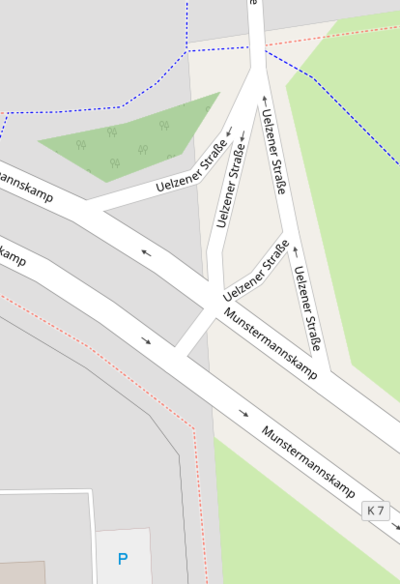
|
Carriageways in merging road: dual common Links from merging road: 0 Carriageways in receiving road: double Connection between receiving carriageways: single |
|
| 30 | Image tbd | Carriageways in merging road: dual common Links from merging road: leaving Carriageways in receiving road: double Connection between receiving carriageways: single |
Type 30: Confluence with dual carriageways road merging into dual carriageways road with single connection, leaving link
|
| 31 | Image tbd | Carriageways in merging road: dual common Links from merging road: entering Carriageways in receiving road: double Connection between receiving carriageways: single |
Type 31: Confluence with dual carriageways road merging into dual carriageways road with single connection, entering link
|
| 32 | Image tbd | Carriageways in merging road: dual common Links from merging road: leaving and entering Carriageways in receiving road: double Connection between receiving carriageways: single |
Type 32: Confluence with dual carriageways road merging into dual carriageways road with single connection, leaving and entering links
|
| 33 | Image tbd | Carriageways in merging road: dual common Links from merging road: 0 Carriageways in receiving road: double Connection between receiving carriageways: dual connected |
Type 33: Confluence with dual carriageways road merging into dual carriageways road with separated connection, no links at all
|
| 34 | Image tbd | Carriageways in merging road: dual common Links from merging road: leaving Carriageways in receiving road: double Connection between receiving carriageways: dual connected |
Type 34: Confluence with dual carriageways road merging into dual carriageways road with separated connection, leaving link
|
| 35 | Image tbd | Carriageways in merging road: dual common Links from merging road: entering Carriageways in receiving road: double Connection between receiving carriageways: dual connected |
Type 35: Confluence with dual carriageways road merging into dual carriageways road with separated connection, entering link
|
| 36 | Image tbd | Carriageways in merging road: dual common Links from merging road: leaving + entering Carriageways in receiving road: double Connection between receiving carriageways: dual connected |
Type 36: Confluence with dual carriageways road merging into dual carriageways road with separated connection, leaving and entering link
|
| 37 | Image tbd | Carriageways in merging road: dual common Links from merging road: 0 Carriageways in receiving road: double Connection between receiving carriageways: dual separated |
Type 37: Confluence with dual carriageways road merging into dual carriageways road with separated connection, no links at all
|
| 38 | Image tbd | Carriageways in merging road: dual common Links from merging road: leaving Carriageways in receiving road: double Connection between receiving carriageways: dual separated |
Type 38: Confluence with dual carriageways road merging into dual carriageways road with separated connection, leaving link
|
| 39 | Image tbd | Carriageways in merging road: dual common Links from merging road: entering Carriageways in receiving road: double Connection between receiving carriageways: dual separated |
Type 39: Confluence with dual carriageways road merging into dual carriageways road with separated connection, entering link
|
| 40 | Image tbd | Carriageways in merging road: dual common Links from merging road: leaving + entering Carriageways in receiving road: double Connection between receiving carriageways: dual separated |
Type 40: Confluence with dual carriageways road merging into dual carriageways road with separated connection, leaving and entering links
|
| 41 | Image tbd | Carriageways in merging road: dual common Links from merging road: 0 Carriageways in receiving road: double Connection between receiving carriageways: dual reverse |
Type 41: Confluence with dual carriageways road merging into dual carriageways road with dual reverse connection, no links at all
|
| 42 | Image tbd | Carriageways in merging road: dual common Links from merging road: leaving Carriageways in receiving road: double Connection between receiving carriageways: dual reverse |
Type 42: Confluence with dual carriageways road merging into dual carriageways road with dual reverse connection, leaving link
|
| 43 | Image tbd | Carriageways in merging road: dual common Links from merging road: entering Carriageways in receiving road: double Connection between receiving carriageways: dual reverse |
Type 43: Confluence with dual carriageways road merging into dual carriageways road with dual reverse connection, entering link
|
| 44 | Image tbd | Carriageways in merging road: dual common Links from merging road: leaving + entering Carriageways in receiving road: double Connection between receiving carriageways: dual reverse |
Type 44: Confluence with dual carriageways road merging into dual carriageways road with dual reverse connection, leaving + entering link
|
| 45 | 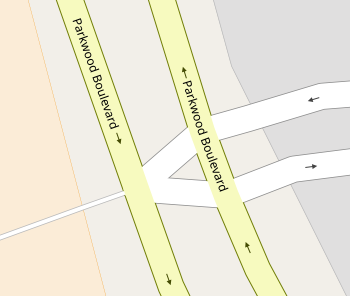
|
Carriageways in merging road: dual separated Links from merging road: 0 Carriageways in receiving road: double Connection between receiving carriageways: dual connected |
|
| 46 | Image tbd | Carriageways in merging road: dual separated Links from merging road: leaving Carriageways in receiving road: double Connection between receiving carriageways: dual connected |
Type 46: Confluence with dual carriageways road merging into dual carriageways road with separated connection, leaving link
|
| 47 | Image tbd | Carriageways in merging road: dual separated Links from merging road: entering Carriageways in receiving road: double Connection between receiving carriageways: dual connected |
Type 47: Confluence with dual carriageways road merging into dual carriageways road with separated connection, entering link
|
| 48 | Image tbd | Carriageways in merging road: dual separated Links from merging road: leaving + entering Carriageways in receiving road: double Connection between receiving carriageways: dual connected |
Type 48: Confluence with dual carriageways road merging into dual carriageways road with separated connection, leaving + entering links
|
| 49 | Image tbd | Carriageways in merging road: dual separated Links from merging road: 0 Carriageways in receiving road: double Connection between receiving carriageways: dual separated |
Type 49: Confluence with dual carriageways road merging into dual carriageways road with separated connection, no links at all
|
| 50 | Image tbd | Carriageways in merging road: dual separated Links from merging road: 0 Carriageways in receiving road: double Connection between receiving carriageways: dual separated |
Type 50: Confluence with dual carriageways road merging into dual carriageways road with separated connection, no links at all
|
| 51 | Image tbd | Carriageways in merging road: dual separated Links from merging road: 0 Carriageways in receiving road: double Connection between receiving carriageways: dual separated |
Type 51: Confluence with dual carriageways road merging into dual carriageways road with separated connection, no links at all
|
| 52 | Image tbd | Carriageways in merging road: dual separated Links from merging road: 0 Carriageways in receiving road: double Connection between receiving carriageways: dual separated |
Type 52: Confluence with dual carriageways road merging into dual carriageways road with separated connection, no links at all
|
| 53 | Image tbd | Carriageways in merging road: dual separated Links from merging road: 0 Carriageways in receiving road: double Connection between receiving carriageways: dual reverse |
Type 53: Confluence with dual carriageways road merging into dual carriageways road with dual reverse connection, no links at all
|
| 54 | Image tbd | Carriageways in merging road: dual separated Links from merging road: 0 Carriageways in receiving road: double Connection between receiving carriageways: dual reverse |
Type 54: Confluence with dual carriageways road merging into dual carriageways road with dual reverse connection, no links at all
|
| 55 | Image tbd | Carriageways in merging road: dual separated Links from merging road: 0 Carriageways in receiving road: double Connection between receiving carriageways: dual reverse |
Type 55: Confluence with dual carriageways road merging into dual carriageways road with dual reverse connection, no links at all
|
| 56 | Image tbd | Carriageways in merging road: dual separated Links from merging road: 0 Carriageways in receiving road: double Connection between receiving carriageways: dual reverse |
Type 56: Confluence with dual carriageways road merging into dual carriageways road with dual reverse connection, no links at all
|